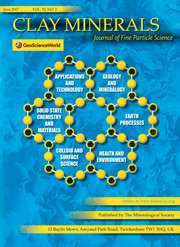Crossref Citations
This article has been cited by the following publications. This list is generated based on data provided by
Crossref.
Brindley, G. W.
and
Nakahira, M.
1956.
A Kinetic Study of the Dehydroxylation of Kaolinite.
Clays and clay minerals (National Conference on Clays and Clay Minerals),
Vol. 5,
Issue. ,
p.
266.
Adhikari, M.
and
Majumdar, M. K.
1972.
Energy Changes in Dehydroxylation of Silicate Minerals.
Transactions of the Indian Ceramic Society,
Vol. 31,
Issue. 5,
p.
127.
Merzhanov, A. G.
1973.
Nonisothermal methods in chemical kinetics.
Combustion, Explosion, and Shock Waves,
Vol. 9,
Issue. 1,
p.
3.
Adhikari, M.
Mukhopadhyay, T. K.
and
Majumdar, M. K.
1982.
Energy Changes in Dehydroxylation of Bauxite Minerals.
Transactions of the Indian Ceramic Society,
Vol. 41,
Issue. 2,
p.
37.
Adhikari, M.
Majumdar, M. K.
and
Pati, A. K.
1983.
Thermal Decomposition of Vermiculites: Kinetics of Dehydration and Dehydroxylation Processes.
Transactions of the Indian Ceramic Society,
Vol. 42,
Issue. 5,
p.
124.
White, Claire E.
Kearley, Gordon J.
Provis, John L.
and
Riley, Daniel P.
2013.
Inelastic neutron scattering analysis of the thermal decomposition of kaolinite to metakaolin.
Chemical Physics,
Vol. 427,
Issue. ,
p.
82.
Duce, Celia
Vecchio Ciprioti, Stefano
Ghezzi, Lisa
Ierardi, Vincenzo
and
Tinè, Maria Rosaria
2015.
Thermal behavior study of pristine and modified halloysite nanotubes.
Journal of Thermal Analysis and Calorimetry,
Vol. 121,
Issue. 3,
p.
1011.
Gualtieri, A. F.
Ricchi, A.
Lassinantti Gualtieri, M.
Maretti, S.
and
Tamburini, M.
2016.
Kinetic study of the drying process of clay bricks.
Journal of Thermal Analysis and Calorimetry,
Vol. 123,
Issue. 1,
p.
153.
Vecchio Ciprioti, Stefano
and
Catauro, Michelina
2016.
Synthesis, structural and thermal behavior study of four Ca-containing silicate gel-glasses.
Journal of Thermal Analysis and Calorimetry,
Vol. 123,
Issue. 3,
p.
2091.
Liu, Chuanjiang
Wang, Duojun
Zheng, Haifei
and
Liu, Tao
2017.
A dehydroxylation kinetics study of brucite Mg(OH)2 at elevated pressure and temperature.
Physics and Chemistry of Minerals,
Vol. 44,
Issue. 4,
p.
297.
Masumoto, Hirokazu
Kameda, Jun
Arima, Hiroshi
Sugiyama, Kazumasa
Nagai, Takaya
and
Yamamoto, Yuzuru
2018.
Dehydroxylation Kinetics of Clay Minerals and Its Application to Friction Heating Along an Imbricate Thrust in an Accretionary Prism.
Geochemistry, Geophysics, Geosystems,
Vol. 19,
Issue. 9,
p.
2991.
Singh, Vikash
and
Srivastava, Vimal Chandra
2022.
Insight into the thermal kinetics and thermodynamics of sulfuric acid plant sludge for efficient recovery of sulfur.
Waste Management,
Vol. 140,
Issue. ,
p.
233.
Komandur, Janaki
Vinu, R
and
Mohanty, Kaustubha
2022.
Pyrolysis kinetics and pyrolysate composition analysis of Mesua ferrea L: A non-edible oilseed towards the production of sustainable renewable fuel.
Bioresource Technology,
Vol. 351,
Issue. ,
p.
126987.
Li, Rui
He, Weilong
Duan, Jiangfei
Feng, Shengxia
and
Zhang, Yu
2022.
Thermal properties and pyrolysis kinetics of phosphate-rock acid-insoluble residues.
Waste Management,
Vol. 146,
Issue. ,
p.
77.
Ali, Labeeb
Kuttiyathil, Mohamed Shafi
Al-Harahsheh, Mohammad
and
Altarawneh, Mohammednoor
2023.
Kinetic parameters underlying hematite-assisted decomposition of tribromophenol.
Arabian Journal of Chemistry,
Vol. 16,
Issue. 3,
p.
104540.
Cerda-Barrera, Cristian
Fernández-Andrade, Kevin J.
and
Alejandro-Martín, Serguei
2023.
Pyrolysis of Chilean Southern Lignocellulosic Biomasses: Isoconversional Kinetics Analysis and Pyrolytic Products Distribution.
Polymers,
Vol. 15,
Issue. 12,
p.
2698.
Chowdhury, Zinnia
Barma, Sanjib
Sen, Dwaipayan
and
Sarkar, Aparna Ray
2024.
PET pyrolysis: Kinetics of a‐graphite.
Environmental Quality Management,
Vol. 33,
Issue. 4,
p.
843.
Gao, Wei
Zhang, Yongzheng
Wang, Yanli
and
Zhan, Liang
2024.
Pyrolysis characteristics and kinetic analysis of coating pitch derived from ethylene tar using model-free and model-fitting methods.
Journal of Analytical and Applied Pyrolysis,
Vol. 183,
Issue. ,
p.
106803.
Mohan, Indra
Sahoo, Abhisek
Mandal, Sandip
and
Kumar, Sachin
2024.
Kinetic modeling and thermogravimetric investigation of Phoenix dactylifera and Phyllanthus emblica non-edible oil seeds: artificial neural network (ANN) prediction modeling.
Biomass Conversion and Biorefinery,
Vol. 14,
Issue. 17,
p.
20635.
Salucci, Emiliano
D’Angelo, Antonio
Russo, Vincenzo
Grénman, Henrik
and
Saxén, Henrik
2025.
Review on the Reduction Kinetics of Iron Oxides with Hydrogen-Rich Gas: Experimental Investigation and Modeling Approaches.
Industrial & Engineering Chemistry Research,
Vol. 64,
Issue. 1,
p.
1.


